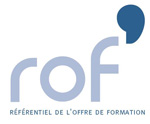ROF - L’Amue à la rencontre des établissements pilotes
 Dans le cadre de la phase d’accompagnement des sites pilotes ROF, l’Amue s’est rendue à l’URCA, à l’université de Poitiers et à Aix-Marseille-Université afin d’effectuer un point sur l’état d’avancement de l’implantation du ROF et de rencontrer les équipes projet.
Dans le cadre de la phase d’accompagnement des sites pilotes ROF, l’Amue s’est rendue à l’URCA, à l’université de Poitiers et à Aix-Marseille-Université afin d’effectuer un point sur l’état d’avancement de l’implantation du ROF et de rencontrer les équipes projet.Présentation du Référentiel de l'Offre de Formation (ROF)
Le Référentiel de l’Offre de Formation vient compléter les systèmes d’information des établissements.
Il permet de constituer le catalogue de l’offre de formation depuis la construction du dossier d’habilitation jusqu’à la mise à disposition des informations nécessaires à sa publication. Ces informations peuvent ensuite être mobilisées dans plusieurs modèles, et notamment sur les les portails destinés aux étudiants.
Le ROF est un outil à la fois autonome et complémentaire à Apogée. Une interface permet d'alimenter Apogée en partie, à partir des données de la structure des enseignements décrits dans ROF.
Avec le ROF, l'établissement dispose:
- d’un référentiel de l’offre de formation fiable (une unique source d’information standardisée),
- d’un outil disponible pour l'ensemble des acteurs intervenant dans la définition de l’offre de formation,
- d’un outil qui s’intègre facilement au système d’information.
Dès l'année 2011, ROF sera utilisé par 4 établissements pilotes: Aix-Marseille Université, Université Montpellier 2, Université de Poitiers, Université de Reims Champagne Ardenne. Ce référentiel sera ensuite proposé à l’ensemble des établissements adhérents selon trois vagues de déploiement s’étalant entre 2012-2014.
Les avantages, limites et principales fonctionnalités de ROF sont décrits dans le support présenté au club utilisateur Apogée 2010.
Le calendrier général
A l'issue de la période pilote, qui s'étalera de janvier 2011 à avril 2012, ROF sera déployé industriellement. Il est prévu 3 vagues importantes de déploiement, démarrant en janvier 2012, janvier 2013 et janvier 2014. Chaque vague comportera 3 phases:
- Une phase de pré-implantation de 3 mois
- Une phase d'implantation de 4 mois
- Une phase de suivi d'environ 16 mois.
Voir aussi sur le blog: Aix-Marseille Université pilote pour le ROF.
 As part of the support phase of the pilot sites ROF, the EUAM went to the URCA, at the University of Poitiers and Aix-Marseille University to perform an update on the status of progress of the implementation of the ROF and meet with project teams.
As part of the support phase of the pilot sites ROF, the EUAM went to the URCA, at the University of Poitiers and Aix-Marseille University to perform an update on the status of progress of the implementation of the ROF and meet with project teams. Presentation of Reference of the Training Offer (ROF)
The world's Training Offer complements the information systems of institutions.
It can be the catalog of training opportunities for the construction of the file to enabling the provision of information for publication. This information can then be mobilized in several models, including the portals for students. See also the blog: Aix-Marseille University driver for the ROF. More...











/https%3A%2F%2Fprofilepics.canalblog.com%2Fprofilepics%2F1%2F0%2F1076071.jpg)